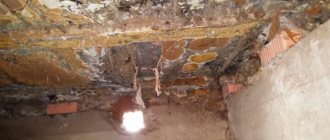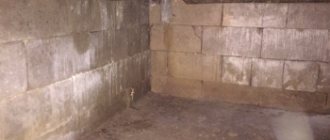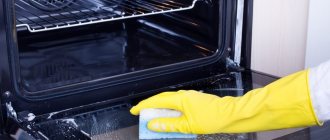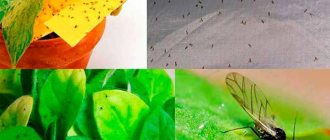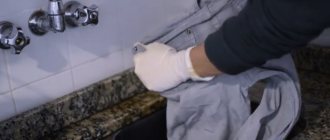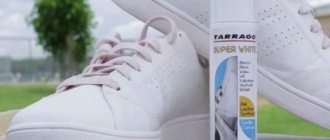Owners of their own homes know that their building is their fortress; it is cozy, comfortable and safe. However, not everyone is able to protect their home from various “invaders.” Unexpected visitors appear in premises against the wishes of the residents, and it can be extremely difficult to get rid of them. We are talking about a living threat that tirelessly searches for its “piece of paradise”, and often finds it. Mold in the basement of a private house is a problem that many owners have to face. These microorganisms appear unnoticed, but after the formation of a large colony, it becomes almost impossible to remove them. To free yourself from the “scourge”, you need to learn effective ways to fight the fungus, and then begin to act - purposefully and ruthlessly.
Reasons for appearance
Mold is quite common in the basement. The fungus affects vegetables stored in the cellar, boxes and boxes in which food is stored, wooden floors, doors, as well as the walls and ceiling of the room. There can be several reasons for the appearance of mold in the cellar.
Ventilation
When the air in the cellar circulates poorly due to lack of ventilation, especially in the case of stagnant air masses, the most favorable conditions are created for the growth and development of mold. This situation can arise if the ventilation system is not provided, is not properly equipped, or is clogged.
Humidity
Ventilation problems also cause increased humidity in the cellar, which can be avoided if the room is regularly and thoroughly ventilated. When moisture accumulates, condensation forms, in which case mold will almost certainly appear.
Spoiled products
The fungus has the ability to spread quickly. If products contaminated with spores are placed in the cellar for storage, they will easily spread to other supplies stored in the basement, the walls and ceiling of the room. In the presence of a favorable environment, mold brought on the surface of rotten products will grow at high speed throughout the cellar.
Infested wood products
No less quickly, a fungus that has infected wooden boxes or other containers in which vegetables or root crops were brought will spread over the surfaces of the cellar. Increased humidity and heat in the room promote the growth and development of mold.
How to remove and destroy
There are a lot of means to combat mold. Some are more effective, some are less...
But before you start work, you need to take care of your own protection - glasses, gloves, a respirator. Personal protective equipment will protect you from inhaling mold spores and substances with which you will carry out the treatment.
Antifungal drugs
The product is a real biological weapon - a solution of bacteria that destroys mold but does not harm humans. The effect, however, is not immediate; the effect is noticeable already on the third day. The idea is that “good bacteria” grow and crowd out “bad fungi.” The product is made on the basis of probiotics (made in Belgium). The price is rather high - about 900 rubles.
Solutions for treating wood infected with fungus
It is not difficult to prepare such solutions yourself; most of the components can be found in construction or hardware stores.
Antiseptic primer
Thanks to the polymers contained in the antiseptic primer, moisture is not able to penetrate into the clogged pores of the wood, plus the antiseptic has its effect.
Treatment with such a product during construction or renovation will protect your basement from fungal formations (you won’t have to rack your brains later about how to get rid of fungus in a wooden house). In general, the treatment is not such a complicated process, so it can be carried out independently for the purpose of prevention or after the appearance of mold.
Bleach
The first remedy in terms of frequency of use in the fight against mold. It can be regular bleach, but it must be chlorine based. It is necessary to dilute it with water - 1:10. Before processing, be sure to wear rubber gloves, as chlorine is a very caustic component. After which the affected surface of the room is treated with the prepared solution. It is also worth remembering that bleach vapors are very toxic and can cause poisoning in humans.
Therefore, you need to pay special attention to the flow of fresh air into the room. You can put a fan on the basement window and turn it on, so it will drive air from outside into the room.
Vinegar
Vinegar is good because it is easily accessible and harmless.
It is better to apply it to the affected areas by spraying; for this you can use a spray bottle. First, acetic acid is sprayed onto the mold, and then all these deposits need to be cleaned off. Spray the vinegar generously again and leave for a couple of hours. Afterwards simply wipe with a damp cloth.
Ammonia
You need to work with ammonia in the same way as with vinegar - that is, spray it on the mold. But in its pure form, ammonia will be difficult to use, so you need to mix it with water in a one-to-one ratio.
The treatment must be carried out with increased safety measures, since the caustic vapors of ammonia can lead to dizziness and poisoning. Therefore, you should not forget about organizing the flow of fresh air.
Baking soda
Baking soda, in addition to disarming the fungus itself, will also clear the air of the unpleasant smell of mold.
The baking soda needs to be wet. Then use a damp cloth, dipped in soda, to walk over the infected areas of the wood. Having thus removed the fungal formations, you need to remove the remaining baking soda from the surface and go over again with a damp cloth. Then leave the room to ventilate.
Sodium fluoride
You need to be extremely careful with this drug, as it is very toxic and dangerous to humans, animals and insects. With the abundance of various mold repellents, it is worth considering whether it is necessary to use such a dangerous substance in the home (it is mainly used in logging enterprises to protect logs from bark beetles and blue mold).
Sodium fluoride is poorly soluble in water, so it is used in the form of a paste. Clay is used as an additional substance, which must first be sifted.
For 1 square meter you will need:
- 150 g sodium fluoride
- 135 g clay
- 200 ml water
Apply the paste to damaged areas of wood and leave to dry.
Folk remedies
The effectiveness of folk remedies is lower, and they can only be fought if there is very little mold. Popular and effective ones include:
- Citric acid (1 tbsp per 1 glass of water)
- Tea tree oil, lavender and rosemary (but too expensive to treat a basement)
- Potassium permanganate (1 tsp potassium salt of permanganate acid per 1 liter of water)
- Iodine solution
To combat the odor after the treatment, you can use baking soda and charcoal. They absorb unpleasant odors very well. Baking soda should be applied to areas where there was previously mold. And coal can simply be placed around the room.
Why is it dangerous?
Mold is dangerous to any surface it touches. Food products affected by fungus should not be eaten. Wooden objects and buildings can be destroyed almost entirely by mold; Previously, oak houses, where the floor was affected by mold, were burned so that neighboring buildings would not be damaged. People staying in a room affected by mold are exposed to harmful substances.
For living organisms
Mold harms all living organisms; it is also dangerous for human health, since when it enters the body it leads to the development of intoxication and allergies. Children, elderly people and those whose bodies are weakened due to illness or decreased immunity are especially affected. The impact of fungi on humans occurs through inhalation of spores, due to contact with skin, as well as through consumption of foods spoiled by mold.
When spores come into contact with the skin, allergic reactions occur. Infection of the mucous membranes with mold spores leads to the appearance of a chronic runny nose and dry cough, and the eyes may become inflamed. The fungus can cause asthmatic attacks and diseases of the cardiovascular system, joint-rheumatic complex.
Prolonged contact with mold can even cause cancer.
For materials and building structures
A mold colony can develop on almost any material - wood, concrete, brickwork, paint. The fungus not only spoils the appearance with unsightly spots of different shades, but also corrodes the surface, and the speed at which the base deteriorates depends on the material and environmental humidity. Wooden objects and structures can turn into dust in a few months.
Fungus in the basement of a private house: means to combat it
There are quite a lot of compounds that help cope with mold, but you need to know which product will be most effective. If the spore colony is still limited to a small area, then there is a chance to get rid of the “enemy” using folk methods - using well-known products.
When the problem is more serious, then it is necessary to act using other methods. Since the fungus has penetrated deeply into the structure of the material, such recipes will be powerless. In this case, it is necessary to purchase special compounds produced by the chemical industry. The third option for solving the problem of “fungus in the basement of a private house” is to call representatives of mold removal services to your home.
Folk remedies
Any drug, even homemade, is unsafe and therefore requires careful handling. Appropriate equipment - gloves, a respirator, goggles and a protective suit - is a must when working with it. There are quite a few folk recipes, not all of them are as effective as possible, but it still makes sense to try some of them, the most effective ones, if the affected area is still small. All products are applied with a sponge, roller, brush, or spray. The last option, a spray, will help disinfect the air.
Whiteness (chlorine)
Chlorine is a well-known means for disinfecting premises. The most popular drugs that contain it remain Whiteness. To successfully get rid of mold, it is recommended to use a concentrated solution. To do this, several bottles of the product are poured into a bucket, then water is added. The caustic nature of the solution is the reason for the need for a respirator, glasses and gloves. The best option is a gas mask and overalls.
Lime with copper sulfate
Using slaked lime as a whitewash is one of the possible options for combating fungus, but this method is far from the only one, and not the most effective. You can enhance the effect of the composition if you add copper sulfate to it: 100 g of copper sulfate is enough for 1 kg of lime. Each product is first diluted with water separately, then diluted lime is poured into the vitriol solution in a thin stream.
Citric acid, vinegar
This “medicine” can be considered only in one case - if the affected area is small. Otherwise, the use of such a product will not be very rational, since the composition will be relatively expensive. At the same time, the solution will rid the room of the specific smell of fungus. Prepare a concentrate: 100 g of citric acid is diluted in 1 liter of water. Vinegar has the same effect.
Hydrochloric acid
This option can be considered as a salvation from fungus, but only if the owners are ready to temporarily empty the cellar of all preparations, since all surfaces and objects must be treated with a weakly concentrated solution. Since even dilute acid is very dangerous, reliable protective equipment is mandatory. The product is diluted according to the instructions.
Boric acid and salt
This is another representative of effective compounds, but in this case in “commonwealth” with sodium chloride. To make an antifungal agent, boric acid (100 ml) and a kilogram of salt are diluted in a 5-liter container with boiling water. There is another recipe used for treating small areas. The composition includes boric acid (250 ml), ordinary vinegar (500 ml), hydrogen peroxide (500 ml) and a liter of hot (up to 70°) water.
Sulfur checkers
The help of smoke bombs is a very effective way that helps get rid of unpleasant mold “neighbors” and pests. However, in this case, all household members will have to leave their home for a while. The procedure itself is quite simple. First, all ventilation holes in the basement are closed. The checker is then placed in a suitable metal container and set on fire. They return to their home a few days later.
Blowtorch
This is another original, but probably reasonable, method. Since mold feels good not only at high levels of humidity, but also loves a comfortable temperature (18-20°), it must be deprived of ideal conditions. For this purpose, blowtorches or gas torches are used. The top layer of material is first removed from the surface to ensure maximum effect from the procedure.
Any of these methods is quite capable of ridding the room of the invasion of mold, which has not yet had time to settle in earnest and for a long time. But the methods will be powerless if the owners cannot establish and eliminate the cause of the fungus. In this case, after some time the “guest” will return.
Special preparations
These are products that solve two problems at once - they rid surfaces of fungus and prevent its growth in the future. The most effective form is deep penetration primers, so you need to become familiar with several of them.
- ArmMix Biocide gel. This primer is ideal for treating concrete and stone (including brick) surfaces. It is available in the form of a concentrate, which is diluted with water (1:5). The advantages of the product are the absence of odor, unsafe components, and low consumption.
- Neomid Bio. This drug is also a concentrate that is completely safe, but is considered to be an effective protection for surfaces made of concrete, brick, stone, etc. Treatment is possible both inside and outside buildings. The main condition for use is precise adherence to proportions.
- Olimp Stop mold. This is the third representative that poses no threat to either people or their pets. This drug can be considered a universal product: it is used for concrete and wooden surfaces. In the first case, it guarantees quick removal of mold, in the second it becomes an antiseptic protective impregnation.
Other effective drugs: ABEDIS 06, Belinka, Biotol-spray, Alpa Fongifluid, Dali, Dulux, Savo.
How to remove dampness
First of all, dampness enters the basement through cracks. They need to be found and eliminated by sealing them with cement mortar, which sometimes requires completely dismantling the covering of the ceiling, walls and floor of the cellar. After this, work is carried out on the installation of external and internal waterproofing.
External waterproofing
To prevent moisture from entering the storage facility, it is best to provide external waterproofing during construction. If you need to redo it, restore it or re-equip it, then the concrete base of the cellar is exposed, cleaned, dried and a layer of waterproofing is applied.
In this case, ready-made coating mixtures for waterproofing, primer, reinforcement, roofing felt, polymer membranes, mastics and other materials are used. After completing the work, backfill with sand, gravel and soil, laying geotextiles and drainage pipes. The final stage is the reinforcement and pouring of the blind area.
Ventilation system
The microclimate in the cellar is very important for long-term storage of food and the prevention of mold, while ventilation will provide an integral part of the microclimate - air circulation. Depending on the size, type and purpose of the storage facility, natural or forced ventilation is installed with a different number of pipes. The simplest type of cellar ventilation is natural with an exhaust and supply pipe. For its correct installation and proper further functioning, several rules must be followed:
- Two pipes are installed in opposite corners of the room - exhaust and supply.
- The supply air supply will provide fresh air; its lower end is located at a height of half a meter from the floor, and its upper end is at a sufficient height above ground level.
- An exhaust pipe, designed to remove air from the storage, is installed in the upper corner of the cellar and protrudes half a meter above the ridge. It is insulated with mineral wool to prevent condensation from accumulating.
- The outer openings of the pipes are protected by canopies from snow and rain.
- The pipe material can be any - metal, plastic, reinforced concrete. Recently, PVC is often used, which is chosen because of its durability and lightness.
- The diameter of the pipes must be the same.
A properly equipped and well-maintained cellar will ensure long-term storage of supplies. If there is mold in the room, this problem can be dealt with using modern and proven means. Timely and thorough antifungal treatment of the cellar will not only preserve food, but also protect the health of its owner.
Source
